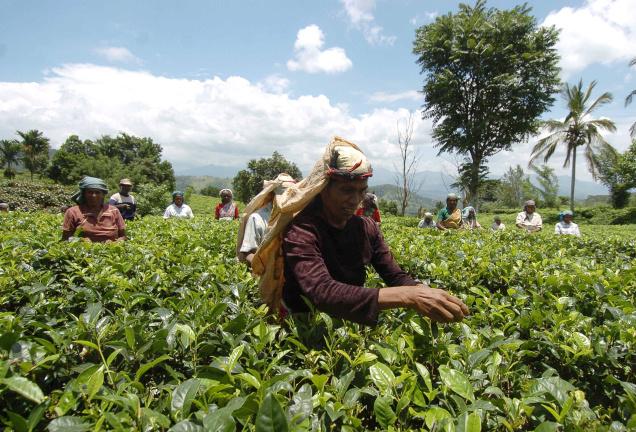![]() Sri Lanka of yore held unalloyed charm
Sri Lanka of yore held unalloyed charm
Betty Kuriyan

AFP(FILES) In this photograph taken on September 8, 2007 Sri Lankan tea pickers work on a plantation in Kandy, some 150 kms north-east of Colombo. The world's biggest tea producers have agreed to bind together in a new organisation designed to raise prices which could hike the cost of a cuppa for consumers, a Sri Lankan minister announced January 23, 2013. AFP PHOTO/Lakruwan WANNIARACHCHI
Sri Lanka, the Emerald Isle of yore, has made multiple transitions in recent decades. But the collage of memories about it from my childhood remains happy and unsullied by time and age.
The island then was a gentle, sun-filled land of upcountry rolling hills and meandering roads of white-washed stupas and incense-filled air; of temples, temple flowers, and lanterns swaying in the balmy air; and of houses in pristine surroundings even if they had only a room or two. The haunting throb of the drums at the Perahara in Kandy fills my ears even now. Memories of Kandy, Colombo, Gampola and Negambo cannot be erased at any time, though grim murder stalked the land in the past few decades.
Gampola, nestling amid hills, where I grew up, was a tranquil little town with steep, sleepy roads and old houses. The pains of growing up were tempered with the untroubled air among the peace-loving Gunawardenes, Fernandos, Alwises, Pelpolas, Kumaraswamys, Selwanyagams, Muthunayagams and Annarajas.
Those were days of togetherness and treks along the hillsides, resting near streams and drinking deep of the cool water, and as children everywhere, sharing the joys of the fruity loot or shivering and quaking together in fear during the scary walk to school by the side of the cemetery.
Could it be that the tranquillity of my childhood days has been consigned to the dusty archives of memory? Could it be that Tamil, Sinhalese and Malayali children will no longer play hop, skip and jump on the long flight of steps that once led to a mythical Kings Treasury upon Hill Street? The colonial descendants had their enclaves of mansions on this street, and we were able to peep in fearful anticipation into their crystal chandeliers and Brussels tapestries through lace-curtained windows overlooking manicured lawns and fragrant rosebushes. Today, merchants have hijacked and converted them into godowns and bric-à-brac shops.
When summoning up remembrances of things past, I cannot think of a more exciting event in our world than the great flood when Barton’s Dam gave way, inundating our valley. The homes we left wide open to the swirling waters remained intact, except for some damage. We 45 families stayed in a sprawling mansion of a Sinhalese neighbour and were fed by a Muslim merchant who opened his godown and poured out goodies for us. All mothers chipped in, and it was heyday for us children. Can those dear days ever come back?
The woods were lovely, dark and deep, and it was a good time for both grown-ups and children when spring was in the air? Christmas, Wesak, Ramzan and Pongal were exciting days for us. Hovering in my memory are those trays of sweetmeats under snowy white, pillow-lace covers sent as gifts from house to house. No gift-wrapping, no racial overtones; only feelings of delicious anticipation.
Holidays saw our homes filled to the seams with friends of all groups, many of them staying for lunch to taste Kerala food. We raided pantries in every home to assuage those in-between mealtime pangs with Kokis, Kalu Dhodhol, or rose cookies, and heavenly Vattalapam. It was a rampage with a difference.
The Peradeniya gardens were an exciting botanical wonderland for schoolchildren and picnickers. I wonder whether I would be fortunate again to see the giant vanda in full bloom in the orchid house. It was undiluted joy to stand in amazed awe by the ancient travellers’ palm trees with names carved on it by besotted visitors or be bemused by the size of the coco de mer nuts.
Fifty years later, I sadly realise that the land which nurtured me has changed. The current coinage is mainly Sinhalese, but one could get by with a mixture of English and sign language. The convent school I studied is now a government Vidyalaya. Names that conjured up a thousand fancies and places that captured my youthful imagination have in some way metamorphosed into fragments.
Mythical sirens will no longer sing hauntingly on the coral strand off Sri Lanka — for, the mood of Serendip has been lost forever amid the noise of gunfire and blazing human hearts.
From : The Hindu : http://www.thehindu.com/opinion/open-page/of-an-island-of-springs-stupas-and-serendipity/article6689633.ece




